Subtotal: £12.58
Blyth’s Archerfish – Toxotes blythii, Stunning Brackish Fish That Thrives in Aquariums, Perfect for Community Tanks and Exotic Fish Enthusiasts in the UK, Thriving Addition to Your Fish Tank
£58.99 Original price was: £58.99.£50.00Current price is: £50.00.
Welcome these beautiful Blyth’s Archerfish (Toxotes blythii) into your aquarium. Known for their vibrant colors and unique hunting skills, these stunning brackish fish thrive in community tanks. Perfect for tropical fish enthusiasts seeking elegant and graceful companions.
Species Introduction
The Blyth’s Archerfish, scientifically known as Toxotes blythii, is a captivating species that originates from the brackish waters of Southeast Asia. These stunning fish are renowned for their unique ability to shoot jets of water to knock insects off branches above the water surface, showcasing their remarkable hunting skills. Typically found in mangrove swamps and estuaries, Blyth’s Archerfish thrive in environments where freshwater and saltwater mix, making them a perfect addition to a brackish aquarium setup. Their vibrant coloration, characterized by a silvery body with dark vertical stripes, makes them a visual delight for any aquarium enthusiast. As you welcome these beautiful creatures into your aquatic community, understanding their natural habitat is essential for providing optimal care and ensuring their well-being.
Care Requirements Dashboard
✓ Care Level: Moderate
Tank Size: Minimum 75 liters (20 gallons)
Water Parameters: pH 7.0-8.0, Temperature 24-28°C (75-82°F), Hardness 10-20 dGH
| Optimal Living Conditions | |
|---|---|
| Water Temperature | 24-27°C (75-81°F) |
| pH Level | 6.5-7.5 |
| Water Hardness | 4-12 dKH |
| Minimum Tank Size | 80L (20 gal) |
| Salinity | Freshwater |
| Care Level | Beginner Friendly |
Natural Behavior & Temperament
Blyth’s Archerfish are known for their active and curious nature. They exhibit fascinating swimming patterns, often gliding gracefully through the water while occasionally darting to the surface to hunt for prey. In terms of social behavior, these fish are generally peaceful but can display territorial tendencies, especially when establishing their own space within the aquarium. It is important to provide them with ample swimming space and hiding spots to reduce stress and encourage natural behaviors. When welcomed into a community tank, they thrive alongside other peaceful species, making them ideal companions for tropical fish enthusiasts. Observing their interactions and hunting techniques can be a rewarding experience for aquarists, as these fish display intelligence and adaptability in their environment.
Tank Setup Guide
Creating an ideal environment for Blyth’s Archerfish involves replicating their natural habitat as closely as possible. A well-planned brackish aquarium should include a sandy substrate to mimic the riverbeds they are accustomed to. Incorporating driftwood and rocks can provide hiding spots and create a sense of security for these fish. Additionally, live plants such as Java fern and Anubias can enhance the aesthetic appeal of the tank while also offering shelter. It is crucial to ensure that the aquarium has a secure lid, as these fish are known to jump. A good filtration system is essential to maintain water quality, and regular water changes should be part of your maintenance routine to keep the environment stable and healthy.
Water Quality Management
Maintaining optimal water quality is vital for the health and longevity of Blyth’s Archerfish. The ideal pH range for these fish is between 7.0 and 8.0, with a temperature maintained between 24 and 28°C (75-82°F). Regular testing of water parameters is essential to ensure stability. The hardness should be kept between 10 and 20 dGH to mimic their natural brackish environment. It is advisable to use a high-quality water conditioner to remove harmful chemicals from tap water before adding it to the aquarium. Additionally, a reliable filtration system will help to keep the water clean and well-oxygenated, which is crucial for the well-being of your aquatic companions. Regular water changes of 20-30% every two weeks will further contribute to a healthy living environment.
Feeding & Nutrition
Blyth’s Archerfish are carnivorous and thrive on a diet rich in protein. In the wild, they primarily feed on insects and small crustaceans, so it is important to replicate this diet in captivity. High-quality pellets designed for carnivorous fish, along with frozen or live foods such as bloodworms, brine shrimp, and daphnia, should be included in their feeding regimen. A feeding schedule of 2-3 small meals per day is recommended to ensure they receive adequate nutrition without overfeeding. It is essential to monitor their feeding habits and adjust portions accordingly to prevent waste and maintain water quality. Providing a varied diet will not only enhance their health but also promote vibrant coloration and overall vitality.
Compatibility Guide
✓ Suitable Tank Mates: Peaceful community fish
Blyth’s Archerfish are best welcomed with other peaceful species that share similar water requirements. Ideal tank mates include larger tetras, peaceful barbs, and other brackish fish. However, caution should be exercised when introducing smaller fish, as Blyth’s Archerfish may see them as potential prey. Avoid aggressive or overly territorial species that could stress these fish. It is essential to observe interactions closely when introducing new tank mates to ensure compatibility and harmony within the aquarium.
Tank Mate Compatibility Guide
Great Tank Mates
- Species-specific research recommended
Avoid These Tank Mates
- Consult compatibility guides
Compatibility Note: Always research specific species requirements and observe fish behavior when introducing new tank mates. Individual fish personalities can vary!
Health & Wellness
Maintaining the health of Blyth’s Archerfish involves regular monitoring for signs of illness and stress. Common health issues include ich, fin rot, and fungal infections. To prevent these problems, ensure that water quality is consistently maintained, and avoid overstocking the aquarium. Signs of a healthy fish include clear eyes, vibrant coloration, and active behavior. If you notice any signs of illness, such as lethargy, loss of appetite, or unusual swimming patterns, it is crucial to take immediate action. Quarantine any affected fish to prevent the spread of disease and consult with an aquatic veterinarian if necessary. Regular health checks and a proactive approach to care will help ensure your fish friends remain healthy and thrive in their environment.
Breeding Information
Breeding Blyth’s Archerfish in captivity can be a rewarding experience, though it requires specific conditions to encourage spawning. These fish are egg layers, and creating a breeding environment involves providing a separate breeding tank with slightly lower salinity and plenty of hiding spots. The ideal temperature for breeding is around 28°C (82°F). Once the female lays eggs, which can number in the hundreds, the male will guard the nest. After a few days, the eggs will hatch, and the fry will require infusoria or finely crushed flakes until they are large enough to consume larger foods. Providing optimal care for the fry is essential for their survival and growth, and regular water changes will help maintain a healthy environment during this critical stage.
Acclimation Process
Introducing Blyth’s Archerfish to a new aquarium requires a careful acclimation process to minimize stress. Begin by floating the sealed bag containing the fish in the aquarium for about 15-20 minutes to equalize the temperature. After this period, gradually add small amounts of aquarium water to the bag every 5-10 minutes for about an hour. This slow acclimation allows the fish to adjust to the water parameters of their new environment. Once acclimated, gently release the fish into the tank using a net to avoid adding any transport water that may contain harmful substances. Monitoring the fish closely for the first few days after introduction is crucial to ensure they adapt well to their new home.
Long-term Care
Blyth’s Archerfish can live for several years with proper care and attention. As they grow, it is essential to monitor their size and adjust tank conditions accordingly. Regular maintenance, including water changes and equipment checks, will help maintain a stable environment. Providing a varied diet and observing their behavior will also contribute to their happiness and health. Keeping a log of water parameters and any changes in behavior can help you identify potential issues early on. As these fish mature, they may become more territorial, so ensuring that the tank is adequately sized and decorated will help mitigate any aggression.
Natural Habitat Recreation
To create a biotope that closely resembles the natural habitat of Blyth’s Archerfish, consider incorporating elements such as mangrove roots, driftwood, and sandy substrates. This setup not only enhances the aesthetic appeal of your aquarium but also provides essential hiding spots and territories for the fish. Using brackish water with appropriate salinity levels will help replicate their natural environment. Additionally, including live plants can promote natural behavior and provide cover for shy individuals. A well-planned aquascape will not only benefit the fish but also create a beautiful display that showcases the unique characteristics of Blyth’s Archerfish.
Seasonal Care Adjustments
As seasons change, so too can the needs of your Blyth’s Archerfish. During warmer months, it may be necessary to monitor water temperature closely, ensuring it remains within the ideal range. Additionally, increased evaporation during hot weather may require more frequent water top-offs. In colder months, maintaining stable temperatures is crucial to prevent stress. Adjusting lighting duration and intensity can also be beneficial, as natural light cycles can influence fish behavior and health. Being attentive to these seasonal changes will help you provide the best care for your aquatic companions.
Expert Tips
For those looking to provide the best care for Blyth’s Archerfish, consider the following expert tips: ensure that your aquarium is well-planted to provide both hiding spots and open swimming areas. Regularly test water parameters to maintain stability, as these fish are sensitive to changes in their environment. Additionally, consider using a high-quality protein-rich diet to enhance their coloration and vitality. Observing their behavior can also provide insights into their health; active and curious fish are generally happy and well-adjusted. Lastly, engage in regular maintenance routines to keep the aquarium clean and the fish healthy.
Troubleshooting
Common issues with Blyth’s Archerfish can often be traced back to water quality and tank conditions. If you notice signs of stress, such as rapid gill movement or hiding, it may indicate poor water quality. Conduct a water test to check for ammonia, nitrite, and nitrate levels, and perform a water change if necessary. If your fish are exhibiting unusual behavior, such as lethargy or loss of appetite, it is important to assess their diet and ensure they are receiving adequate nutrition. Keeping a close eye on your fish and their environment will help you address any issues promptly and effectively.
Scientific Background
The Blyth’s Archerfish belongs to the family Toxotidae and is part of the order Perciformes. This family is known for its unique adaptations to brackish environments and includes several species capable of shooting jets of water to capture prey. The scientific classification of Blyth’s Archerfish highlights its evolutionary adaptations that allow it to thrive in fluctuating salinity levels. Conservation efforts are essential to protect their natural habitats, as human activities such as pollution and habitat destruction pose significant threats to their populations. Understanding the scientific background of these fish can enhance your appreciation for their beauty and the importance of responsible aquarium keeping.
Advanced Care Techniques
For those looking to elevate their care for Blyth’s Archerfish, consider implementing advanced techniques such as creating a dynamic environment with varied water flow and lighting. Experimenting with different types of food can also enhance their health and coloration. Additionally, consider establishing a breeding pair and providing them with a dedicated breeding tank to encourage natural spawning behaviors. Engaging in regular observation and recording behavioral changes can help you understand their needs better and adjust care accordingly. By investing time and effort into advanced care techniques, you can ensure that your Blyth’s Archerfish thrive in their aquatic home.
Water Quality Parameters
Optimal Range
24-27°C
6.5-7.5
0 ppm
Caution Zone
22-24°C or 27-29°C
6.0-6.5 or 7.5-8.0
0.25-0.5 ppm
Danger Zone
<22°C or >29°C
<6.0 or >8.0
>0.5 ppm
Monitoring Tip: Test water parameters weekly and perform regular water changes to maintain optimal conditions for your aquatic friends!
Frequently Asked Questions
Q: What tank size is required for Blyth’s Archerfish?
Blyth’s Archerfish thrive in spacious environments, so a minimum tank size of 200 litres is recommended for a small group. This allows them ample swimming space and reduces territorial disputes. A larger tank is preferable, especially for community setups, as it aids in maintaining stable water parameters. Ensure the aquarium is well-filtered and has sufficient surface area for oxygen exchange, as these fish are surface feeders and require clear access to the water’s surface for their natural feeding behaviours.
✓ Expert Tip
Consider a tank with a height of at least 60 cm to accommodate their jumping behaviour, as they may leap out of the tank if startled.
Q: What water parameters do Blyth’s Archerfish require?
Blyth’s Archerfish are brackish species, requiring specific water parameters to thrive. Ideally, maintain a salinity level between 1.005 to 1.015 SG. The pH should be between 7.0 and 8.0, with a temperature range of 24-28°C. Regular water changes of 10-15% weekly are crucial to keep toxin levels low and ensure optimal health. Use a hydrometer to check salinity and a high-quality test kit for pH and ammonia levels. Maintaining these parameters will help prevent stress and disease.
✓ Expert Tip
Consider using marine salt mix to achieve the desired salinity and avoid regular table salt, which can be harmful.
Q: How often should I feed Blyth’s Archerfish?
Blyth’s Archerfish are natural surface feeders, and they should be fed 2-3 times a day. A varied diet is essential to meet their nutritional needs, including high-quality pellets, freeze-dried or live foods like brine shrimp and bloodworms. Be cautious not to overfeed, as uneaten food can pollute the water. Observe their feeding behaviour; they should eagerly snap at food, indicating they are healthy and active. Adjust portions based on the number of fish and their size to maintain optimal water quality.
✓ Expert Tip
Incorporate a mix of foods to encourage natural foraging behaviours, enhancing their well-being.
Q: What are the best tank mates for Blyth’s Archerfish?
Blyth’s Archerfish are generally peaceful but can be territorial, particularly during breeding. Suitable tank mates include larger, non-aggressive species such as Rainbowfish, larger Tetras, or Gouramis. Avoid smaller fish that may be seen as prey, as Archerfish are opportunistic hunters. Ensure that the tank is spacious enough to allow all species to establish their territories. Monitor interactions, especially during feeding times, to prevent stress or aggression among tank mates.
✓ Expert Tip
Introduce new fish gradually to minimise territorial disputes and allow for acclimatisation.
Q: How do I properly acclimatise Blyth’s Archerfish to my aquarium?
Acclimatisation is crucial for Blyth’s Archerfish to reduce stress and ensure a smooth transition to their new environment. Start by floating the sealed bag containing the fish in the aquarium for about 15-20 minutes to equalise the temperature. Then, gradually introduce small amounts of aquarium water into the bag every 10-15 minutes over the course of an hour. This slow process helps the fish adjust to the new water parameters. After acclimatisation, gently net the fish into the aquarium, avoiding adding bag water to the tank.
✓ Expert Tip
Keep the aquarium lights dim during acclimatisation to reduce stress and encourage exploration.
Q: What are the signs of healthy Blyth’s Archerfish?
Healthy Blyth’s Archerfish exhibit vibrant colours, clear eyes, and active swimming behaviour. They should be responsive to feeding and show curiosity towards their environment. Inspect their fins and body for any signs of damage or lesions, which can indicate stress or disease. Healthy fish will also display a balanced social behaviour with their tank mates. Regular observation is key, as changes in behaviour, appetite, or appearance can signal underlying health issues that need addressing.
✓ Expert Tip
Keep a journal of your fish’s behaviours and feeding patterns to help identify any changes over time.
Q: How can I prevent common diseases in Blyth’s Archerfish?
Preventing diseases in Blyth’s Archerfish begins with maintaining optimal water quality, including regular water changes and proper filtration. Quarantine new fish before introducing them to the main tank to avoid introducing pathogens. Provide a varied diet to boost their immune system and reduce stress factors. Monitor for signs of disease, such as changes in behaviour or appearance. If illness is suspected, consult a veterinarian or aquatic specialist for appropriate treatment options.
✓ Expert Tip
Maintain a stable environment to reduce stress, as fluctuations in temperature or salinity can lead to disease outbreaks.
Q: What temperature should I maintain for Blyth’s Archerfish?
Blyth’s Archerfish prefer a temperature range of 24-28°C, which mimics their natural brackish habitat. Consistent temperature is critical; fluctuations can stress the fish and make them susceptible to diseases. Use a reliable aquarium heater and thermometer to monitor and maintain the desired temperature. Regularly check the heater’s functionality, especially during seasonal changes, to ensure the environment remains stable and conducive to their health.
✓ Expert Tip
Consider using a programmable heater for precise temperature control and to prevent overheating.
Q: How long do Blyth’s Archerfish typically live in captivity?
In captivity, Blyth’s Archerfish can live for 5 to 10 years, provided they are given optimal care. Factors influencing their lifespan include water quality, diet, and tank conditions. Regular maintenance and monitoring of water parameters significantly contribute to their longevity. Providing a stress-free environment with appropriate tank mates and a balanced diet will enhance their quality of life and overall health, ultimately leading to a longer lifespan.
✓ Expert Tip
Consider keeping a log of your fish’s health and behaviour to spot any issues early on.
Q: What type of substrate is most suitable for Blyth’s Archerfish?
Blyth’s Archerfish prefer a substrate that mimics their natural habitat, which typically consists of sandy or fine gravel. This type of substrate allows for easy movement and foraging, as well as providing a comfortable area for resting. Avoid substrates with sharp edges that could damage their delicate fins. Additionally, incorporating some natural decorations, such as driftwood and rocks, can enhance their environment and provide hiding spots, reducing stress.
✓ Expert Tip
Consider using a substrate that promotes beneficial bacteria growth to aid in maintaining water quality.
Q: What behavioural patterns should I expect from Blyth’s Archerfish?
Blyth’s Archerfish are known for their unique feeding behaviour, often shooting jets of water to knock insects off overhanging branches. They are generally social and enjoy being in groups, displaying active swimming patterns. You may observe them establishing a hierarchy within the tank, with more dominant fish asserting themselves. They can also exhibit curious behaviour towards their environment, often investigating new additions or changes in their habitat.
✓ Expert Tip
Provide plenty of space and hiding spots to encourage natural behaviours and reduce stress.
Q: How do I recognise stress in Blyth’s Archerfish?
Recognising stress in Blyth’s Archerfish is vital for maintaining their health. Signs include erratic swimming, hiding excessively, loss of appetite, and changes in colouration. Additionally, they may become more aggressive towards tank mates or display signs of fin clamping. Regular observation of their behaviour and environment can help identify stressors such as poor water quality, unsuitable tank mates, or inadequate hiding spots. Addressing these issues promptly can prevent further health complications.
✓ Expert Tip
Maintain a stable environment to minimise stress factors, as stability is key to their well-being.
Q: What natural habitat conditions should I replicate for Blyth’s Archerfish?
To create an optimal environment for Blyth’s Archerfish, replicate their natural brackish habitat with a mix of marine and freshwater. Incorporate plants, driftwood, and rocks to simulate their natural surroundings. Maintain slightly elevated salinity levels and ensure the water is well-oxygenated. Providing ample swimming space and shaded areas can help reduce stress and encourage natural behaviours, such as foraging and exploring. Regular monitoring of water parameters will ensure a healthy, thriving environment.
✓ Expert Tip
Consider using natural filtration methods, such as live plants, to enhance water quality and mimic their habitat.

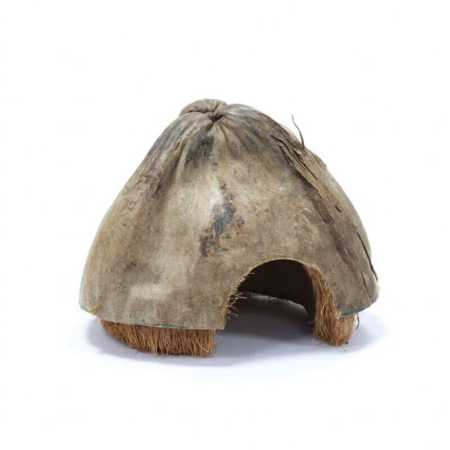
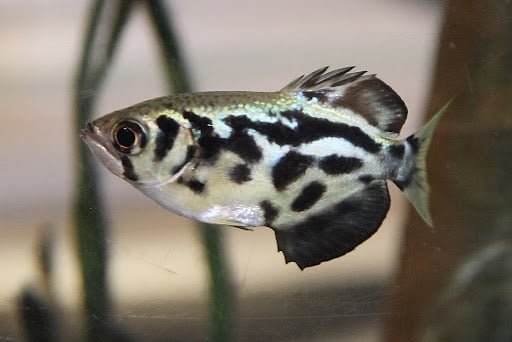
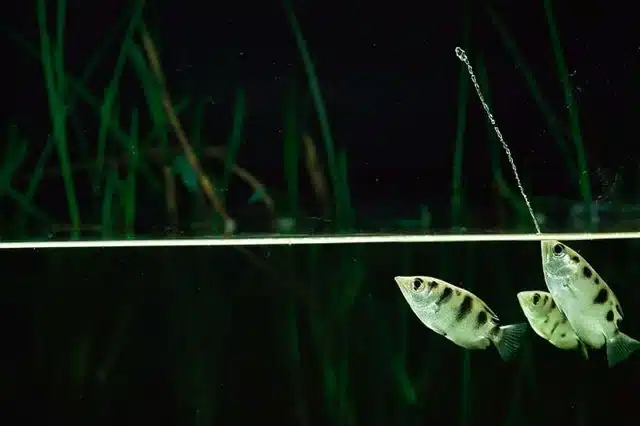
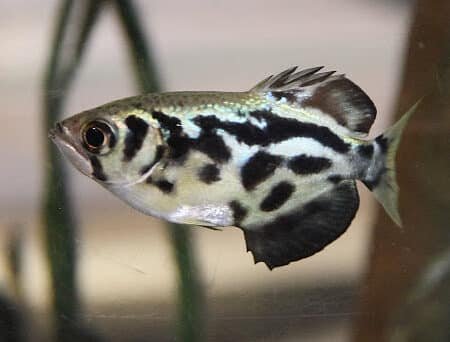
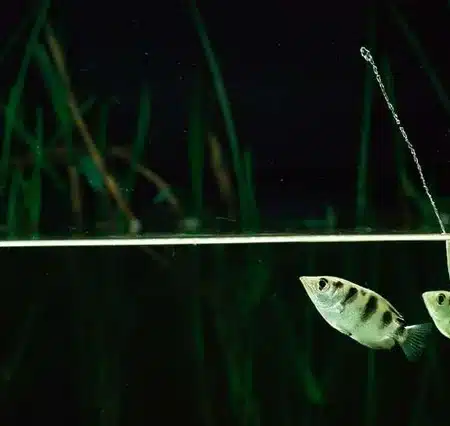
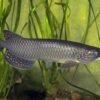
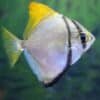









Emily Carter (verified owner) –
I recently added a Blyth’s Archerfish to my brackish fish tank and I couldn’t be more thrilled! These fish are not just beautiful, but they have such an engaging personality. Within a week of introducing my Archerfish, I noticed how curious and active it was, exploring its surroundings and even trying to ‘shoot’ at floating food with precision. It’s incredible to watch!
I’ve kept various freshwater fish before, but the Archerfish’s unique behavior makes it a standout in my aquarium. The setup for a brackish environment is a bit more complex than a standard freshwater setup, but the payoff is worth it. Compared to other species I’ve kept, the Blyth’s Archerfish is far more interactive and visually stunning.
I would recommend this fish to fellow aquarium enthusiasts who enjoy an active, engaging species. Just be sure to provide a tank with adequate space and cover! A minor concern is their specific dietary needs; I’ve found frozen or freeze-dried foods work best. Overall, this sleek fish has brought so much joy to my aquatic family, and I would definitely buy again. Wonderful experience all around!
Clara Thompson (verified owner) –
I recently introduced Blyth’s Archerfish to my aquarium, and I couldn’t be happier! After about two months of observation, these fish have not only adapted beautifully to my brackish setup but have also displayed such fascinating behavior. Watching them shoot water at floating food is not just entertaining, but it truly showcases their natural hunting skills!
My tank is a community one, and these tropical fish have gelled well with my other species like rainbows and barbs. It’s vital to ensure that the tank has enough swimming space and areas to hide, and I’ve incorporated driftwood and plants, which they seem to love. One minor concern is that they can be a bit skittish at first, so offering plenty of cover is key.
I purchased them from a reputable local store, and they arrived healthy and active. I highly recommend Blyth’s Archerfish for anyone looking to enhance their aquarium experience, especially those who love exotic fish. They add character and energy to the tank and are perfect for both seasoned aquarists and those just starting out! Just be sure to maintain the right salinity and a good filtration system. Overall, I would definitely buy them again. Can’t wait to see them grow even larger in my tank!